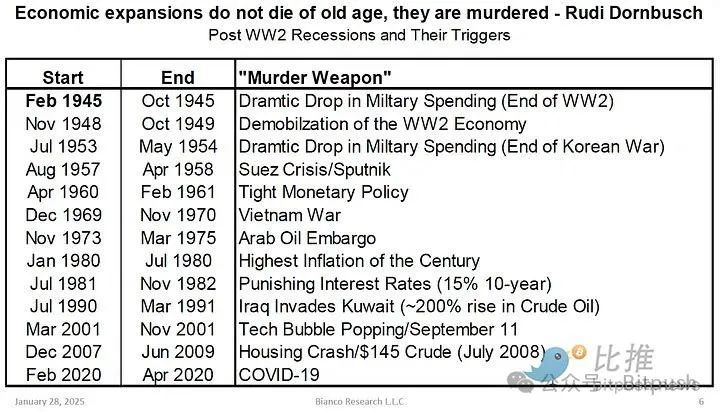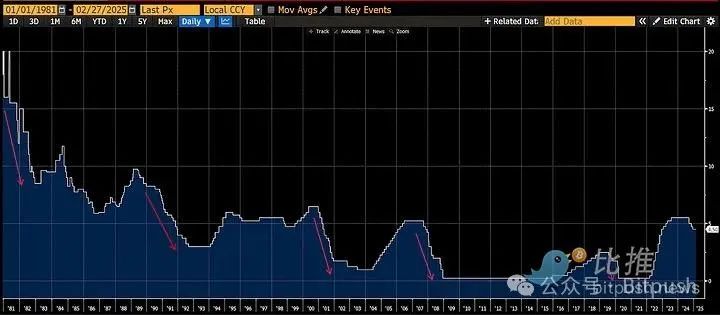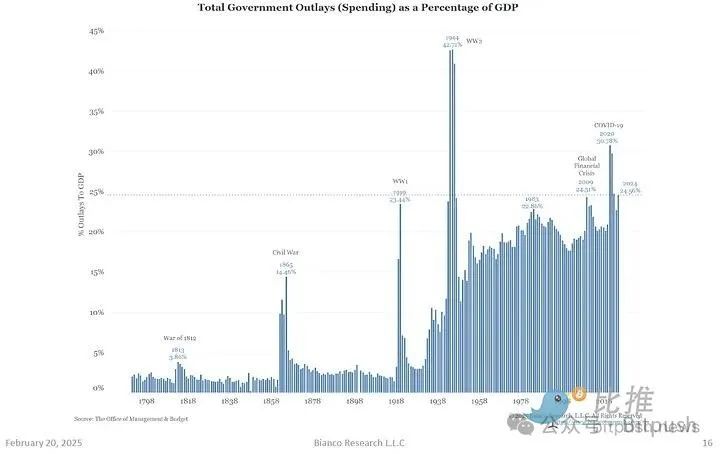By Arthur Hayes
Original title: KISS of Death
Compiled and edited by: BitpushNews

Keep — It — Simple — Stupid = KISS
Many readers tend to forget the KISS principle when dealing with the torrent of policies from U.S. President Donald Trump’s administration.
The goal of Trump’s media strategy is for you to wake up every day and say to your friends, partner, or inner monologue: “Oh my God, did you see what Trump/Musk/JFK Jr. did yesterday? I can’t believe they did that.” Whether you’re excited or depressed, this farce called “The Emperor’s Day” is quite entertaining.
For investors, this constant state of excitement is not conducive to accumulating Bitcoin (sats). You might buy today and quickly sell tomorrow after digesting the next headline. The market keeps oscillating in the process, and your Bitcoin stash shrinks rapidly.
Remember the KISS principle.
Who is Trump? Trump is a master real estate showman. To be successful in real estate, you must master the art of borrowing huge amounts of money at the lowest possible interest rates. Then, in order to sell units or rent out space, you must brag about how impressive the new building or development will be. I am not interested in Trump's ability to elicit sympathy in the global community, but I am interested in his ability to finance policy goals.
I am sure Trump wants to finance his “America First” policies through debt. If not, he will allow the market to naturally clear the credit embedded in the system and usher in a depression worse than the 1930s. Does Trump want to be known as the 21st century Herbert Hoover or Franklin Delano Roosevelt (FDR)? American history disparages Hoover because historians believe he did not print money fast enough, and honors Roosevelt because his New Deal policies were paid for with printed money. I believe Trump wants to be considered the greatest president ever, and therefore, he does not want to destroy the foundations of the empire through austerity.
To emphasize this point, remember that Hoover’s US Treasury Secretary Andrew Mellon said the following about what to do about an over-leveraged US and global economy following the stock market crash:
“Liquidate the labor force, liquidate the stocks, liquidate the farmers, liquidate the real estate. This will purge the corruption from the system. The high cost of living and lavish lifestyles will come down. People will work harder and lead more ethical lives. Values will be adjusted and the enterprising will pick up the wreckage from the less capable.”
Current U.S. Treasury Secretary Scott Bessent is not one to make such outrageous statements.
If my view is correct that Trump will implement "America First" through debt financing, what does this mean for my view of global risk asset markets in the future, especially cryptocurrencies?
To answer this question, I have to form a view on the possible ways that Trump might increase the quantity of money/credit (i.e., print money) and reduce its price (i.e., interest rates). Therefore, I have to form a view on how the relationship between the U.S. Treasury, led by Scott Bessant, and the Federal Reserve, led by Jerome Powell, will evolve.
KISS principle

Who did Besant and Powell serve? Was it the same person?
Bessant was appointed by Trump 2.0, and judging by his past and current interviews, he very much shares the “Emperor’s” worldview.
Powell was appointed by Trump 1.0, but he was an erratic renegade who defected to the Obama and Clinton camps. Powell destroyed what little credibility he had left when he slashed interest rates by 0.5% in September 2024. The economy was growing above trend at the time, and there was still inflation on the horizon, so there was no need for a rate cut. But Obama-Clinton puppet Kamala Harris needed a boost, and Powell dutifully cut rates. It didn’t work out as expected, but after Trump’s victory, Powell announced that he would finish his term and once again firmly fight inflation.
When you have a lot of debt, several things happen.
First, interest payments consume a large portion of your free cash flow. Second, you can’t finance additional asset purchases because no one will lend you money given the high debt levels. So you have to restructure your debt, which requires extending maturities and reducing coupon rates. This is a form of soft default because doing so mathematically reduces the present value of the debt burden. Once your effective debt burden is lower, you can borrow at affordable rates again. Viewed through these lenses, both the Treasury and the Fed have a role to play in restoring America’s financial health. But the success of that effort has been hampered by the fact that Bessant and Powell serve different masters.
Debt restructuring
Bessant has publicly stated that the current structure of the U.S. debt must change. He wants to eventually extend the average maturity of the debt burden, which is known on Wall Street as "debt maturity extension." Various macroeconomic experts have proposed suggestions on how to achieve this goal; I discuss such solutions in detail in The Genie. However, the most important thing for investors is that the United States will softly default on its debt burden by reducing the net present value.
Given the global distribution of U.S. debt holders, it will take time to achieve this restructuring. It is a geopolitical Gordian knot. So in the short term, the next three to six months, this is not relevant to us, the inventors of cryptocurrency.
New Loans
Powell and the Fed have broad control over the amount of credit and its price. The Fed is permitted by law to print money and buy debt securities, thereby increasing the amount of money/credit, i.e. printing money. The Fed also sets short-term interest rates. Given that the US cannot default on nominal dollars, the Fed determines the risk-free interest rate on dollars, the effective federal funds rate (EFFR).
The Fed has four main levers to manipulate short-term interest rates: the reverse repurchase program (RRP), the interest rate on reserve balances (IORB), the fed funds rate floor, and the fed funds rate ceiling. Without delving into the intricacies of money markets, all we need to understand is that the Fed can unilaterally increase the quantity of dollars and decrease their price.
If Bessant and Powell served the same leader, it would be very easy to analyze the future path of US dollar liquidity and the reactions of China, Japan and the EU to US monetary policy. Given that they clearly do not serve the same person, I wonder how Trump can manipulate Powell to print money and lower interest rates while allowing Powell to stick to the Fed's inflation-fighting mission.
Ruining the economy
Fed-Recession Law: If the U.S. economy is in recession, or the Fed is concerned that the U.S. economy is going into recession, it will cut interest rates and/or print money.
Let's test this law using recent economic history (thanks to Bianco Research for this excellent table).

Here is a list of the direct causes of modern US recessions since World War II. A recession is defined as negative quarter-on-quarter GDP growth. I will focus on the 1980s to present.

Here is a chart of the lower bound on the federal funds rate. Each red arrow represents the start of an easing cycle that coincides with a recession. As you can see, it is very clear that the Fed will at least cut rates during a recession.
Fundamentally, the Pax Americana and the global economy it rules are debt-financed. Large corporations issue bonds to finance future expansion of production and current operations. If cash flow growth slows significantly or declines outright, the repayment of the debt will eventually be questioned. This is problematic because corporate liabilities are largely assets of banks. Banks hold corporate debt assets to support their customer deposit liabilities. In short, if debt cannot be repaid, it calls into question the "value" of all legal credit bank notes in existence.
Furthermore, in the US, most households are leveraged. Their consumption patterns are financed at the margin with mortgages, auto loans, and personal loans. If their cash flow generation capacity slows or declines, they will not be able to meet their debt obligations. Again, the banking system holds these debts and backs them with its deposit liabilities.
It is critical that the Fed not allow large-scale defaults or an increase in the probability of defaults on corporate and/or household debts to occur during a recession or before cash flow generation slows or contracts. This would lead to defaults on corporate and consumer debts, leading to systemic financial distress. In order to protect the solvency of the debt-financed economic system, the Fed actively or passively cuts interest rates and prints money whenever a recession occurs or the perception of recession risks increases.
KISS principle
Trump manipulated Powell into easing financial conditions by either causing a recession or convincing markets that a recession was imminent.
To avoid a financial crisis, Powell would then do some or all of the following: cut interest rates, end quantitative tightening (QT), restart quantitative easing (QE), and/or suspend the supplementary leverage ratio (SLR) for banks to buy U.S. Treasuries.
Here is a picture from DOGE:

How did Trump unilaterally trigger a recession?
The marginal driver of US economic growth has always been the government itself. Whether the spending is fraudulent or necessary, government spending creates economic activity. In addition, there is a money multiplier effect on government spending. This is why the Washington, DC metro area is one of the wealthiest areas in the US, because there are a large number of professional parasites there sucking blood from the government. It is difficult to estimate the exact money multiplier directly, but conceptually, it is easy to understand that government spending has a follow-on effect.
According to Perplexity:
● The median household income in Washington, D.C. is $122,246, which is much higher than the national median household income.
● This places Washington, DC in the 96th percentile among U.S. cities in terms of household income.
As a former president, Trump is well aware of the extent of fraud, rigging, and waste that exists within the government. The establishment in both parties does not want to curb this because everyone benefits from it. Given that Trumpists are outside the Democratic and Republican parties, they have no qualms about exposing the flaws in government spending plans. The creation of an advisory board led by Elon Musk and backed by Trump, called the Department of Government Efficiency (DOGE), was the core driving force for rapid and drastic cuts in government spending.
How does DOGE do this when many of the largest spending items are non-discretionary? If a payment is fraudulent, it can be stopped. If computers can replace the government employees who manage these programs, human resource costs will drop dramatically. The question becomes, how much fraud and inefficiency is actually going into government spending each year? If what DOGE and Trump are saying is true, it would be in the trillions of dollars per year.
One example that might be pretty obvious is who the Social Security Administration (SSA) sends checks to. If we believe DOGE’s claims, the department is sending nearly a trillion dollars to deceased people and people whose identities have not been properly verified. I don’t know the truth of this claim. But imagine that you are an SSA benefit fraudster and know that Elon and “the big guys” are digging into the data and may find fraudulent payments you have received over the years and submit them to the Department of Justice. Do you continue your scam or run away? The point is that the mere threat of discovery could lead to a decrease in fraudulent activity. As the old Chinese saying goes, kill the chicken to scare the monkey. So while the establishment media is fooling around with Elon and DOGE, I believe there are hundreds of billions of dollars, if not a trillion.
Now let’s turn to the human resources side of the government spending equation. Trump and DOGE are firing hundreds of thousands of government employees. Whether unions have enough power to mount a legal challenge to this massive purge of “useless” government workers remains to be determined. But the consequences are already being felt.
DeAntonio explained: “The layoffs we have seen so far are likely just the tip of the iceberg. The size and timing of future layoffs will determine whether the labor market can remain stable. We currently expect the number of federal government workers to decline by approximately 400,000 by 2025 due to a continued hiring freeze, delayed resignations, and DOGE-initiated layoffs.”
–Fox Business
Even though Trump 2.0 is just over a month into his presidency, the impact on DOGE is already evident. Unemployment claims in the Washington, D.C., area have surged. Home prices have plummeted. And consumer discretionary spending, arguably fueled by massive fraud and malpractice by the U.S. government, has also disappointed financial analysts’ forecasts. Markets are starting to talk about the word “recession.”
Home prices in Washington, D.C., have fallen 11% since the beginning of the year, according to a new analysis from real estate marketplace Parcl Labs, which tracks the impact of the Department of Government Efficiency (DOGE) actions on the city’s housing market.
–Newsweek
Rothstein posted on Bluesky that the United States is almost certainly heading for a severe economic contraction due to massive layoffs in government departments and the sudden cancellation of federal contracts.
–The Economic Times
The word “recession” carries an economic stigma. Powell doesn’t want to become a modern-day Hester Prinn, so he must respond.
Powell turns again
Powell must be getting dizzy with how many times he has pivoted since 2018. The question for investors is whether Powell will preemptively save the financial system from collapse or will he react after a major financial institution fails. The path Powell chooses is purely political. Therefore, I cannot predict.
But what I do know is that $2.08 trillion of U.S. corporate debt and $10 trillion of U.S. Treasury bonds must be rolled over this year. If the U.S. is on the brink of a recession or in the middle of one, the cash flow shock will make rolling over these huge amounts of debt at current interest rates nearly impossible. So, in order to preserve the sanctity of the Pax Americana financial system, the Fed must and will act.
The question for us crypto investors is how fast and how much will the U.S. unleash credit? Let’s break down the four main steps the Fed will take to turn things around.
Rate cuts
It is estimated that every 0.25% reduction in the federal funds rate is equivalent to $100 billion in quantitative easing or money printing. Assume that the Fed cuts the interest rate from 4.25% to 0%.
That’s the equivalent of $1.7 trillion in quantitative easing. Powell may not cut rates to 0%, but you can be sure Trump will allow Elon to continue cutting spending until Powell gets rates down to a desired level. When an acceptable rate level is reached, Trump will rein in his “mad dog.”
Stop Quantitative Tightening (QT)
The recently released minutes of the Fed’s January 2025 meeting detail that certain committee members believe quantitative tightening must end sometime in 2025. Quantitative tightening is the process by which the Fed reduces the size of its balance sheet, thereby reducing the amount of dollar credit. The Fed conducts $60 billion of quantitative tightening each month. Assuming the Fed begins to act in April, this means that stopping quantitative tightening will inject $540 billion in liquidity in 2025 relative to previous expectations.
Restart of QE/SLR exemption
To absorb the supply of US Treasuries, the Fed could restart QE and grant banks a supplementary leverage ratio exemption. Through QE, the Fed can print money and buy Treasuries, thereby increasing the amount of credit. The supplementary leverage ratio exemption allows US commercial banks to use unlimited leverage to buy Treasuries, thereby increasing the amount of credit. The key point is that both the Fed and the commercial banking system are allowed to create money out of thin air. Restarting QE and granting a supplementary leverage ratio exemption are decisions that only the Fed can make.
If the federal deficit remains in the $1 trillion to $2 trillion per year range, and the Fed or the Bank absorbs half of the new issuance, this implies an increase in the money supply of $500 billion to $1 trillion per year. The 50% participation rate is conservative, as the Fed bought 40% of new issuance during COVID-19. Nonetheless, in 2025, large exporters (China) or oil producers (Saudi Arabia) have stopped or significantly slowed their purchases of Treasuries with their dollar surpluses; thus, the Fed and the Bank have more room to maneuver.
Do the math:
Rate cuts: $1.7 trillion
+
Stop quantitative tightening: $0.54 trillion
+
Restarting QE/SLR Exemption: $500 billion to $1 trillion
=
Total = $2.74 trillion to $3.24 trillion
COVID-19 vs. DOGE Money Printing
In the United States alone, the Federal Reserve and the Treasury Department created about $4 trillion in credit between 2020 and 2022 in response to the Covid-19 pandemic.
DOGE-inspired money printing could reach 70-80% of COVID-19 levels.
Bitcoin has risen about 24x from its 2020 low to its 2021 high due to $4 trillion in money printing in the U.S. alone. Given that Bitcoin’s market cap is much larger now than it was then, let’s be conservative and call the $3.24 trillion increase in money printing in the U.S. alone a 10x. For those asking how Bitcoin could have reached $1 million during the Trump presidency, this is the answer.
Several key assumptions
Even with all the chaos in the market right now, I have painted a very rosy picture for Bitcoin’s future. Let’s look at my assumptions so you can decide for yourself whether they make sense.
Trump will implement "America First" through debt financing.
Trump is using DOGE as a means to purge political opponents addicted to fraudulent revenue streams, cut government spending, and increase the likelihood of a recession sparked by a slowdown in U.S. government spending.
The Fed will adopt a series of policies before or after a recession that increase the quantity of money and reduce the price of money.
It's up to you to decide whether this makes sense or not, depending on your worldview.
U.S. Strategic Reserve
I woke up on Monday morning and saw the Trump rally was activated. On Truth Social, Trump reiterated that the US would build a strategic reserve filled with Bitcoin and a bunch of shitcoins. The market surged on the "news". This was nothing new, but the market saw Trump's reaffirmation of his cryptocurrency policy intentions as an excuse for a violent dead cat bounce.
If this reserve is to have a positive impact on prices, it requires the ability of the U.S. government to actually buy these cryptocurrencies. There is no secret mountain of dollars piling up, waiting to be deployed. Trump needs the help of Republican lawmakers to raise the debt ceiling and/or revalue gold to match current market prices. These are the only two ways to fund a strategic reserve of cryptocurrencies. I'm not saying Trump won't keep his promise, but the time frame in which the purchases may begin may be longer than leveraged traders can hold out before getting blown up. So, sell off on rallies.
Trading strategies
Bitcoin and the broader cryptocurrency market are the only truly global free markets in existence. The price of Bitcoin tells the world, in real time, how the global community views the current state of fiat liquidity. Bitcoin reached a high of $110,000 on the eve of Trump’s coronation in mid-January and hit a local low of $78,000, a drop of about 30%. Bitcoin is screaming that a liquidity crisis is coming, even as US stock market indices remain near all-time highs. I believe Bitcoin’s signal, therefore, that a severe correction in US stocks driven by recession fears is imminent.
If Bitcoin leads the market on the way down, it will do the same on the way up. Given how quickly minor financial turmoil can spread into full-blown panics due to the massive leverage embedded in the system, if my predictions are generally correct, we won’t have to wait long for the Fed to act. Bitcoin will hit bottom first, then rebound first. As for the rotten traditional financial system, led by the U.S. stock market, they will be a little slower to start rising, but they will have to experience a round of collapse before they can catch up.
I firmly believe that we are still in a bull cycle, so the worst case bottom would be the previous cycle's all-time high of $70,000. I'm not sure we'll go that low. A positive USD liquidity signal is that the US Treasury General Account is falling, which acts as a liquidity injection.
Based on my belief in Trump's financier type and his ultimate goals, Maelstrom increased his exposure when Bitcoin was trading in the $80,000 to $90,000 range. If the current situation is just a "dead cat bounce" (a short-lived rebound followed by a continued decline), I expect Bitcoin may revisit the lows of around $80,000.
If the S&P 500 or Nasdaq 100 fall 20% to 30% from their all-time highs, coupled with the near collapse of a large financial institution, we may see a full linkage of global markets. This means that all risk assets will be hit hard at the same time, and Bitcoin may fall below $80,000 again, or even $70,000. Whatever happens, we will be cautious to gradually build positions on the decline without using leverage, in the hope that the global (especially US-led) fiat financial market will re-expand after the final collapse and push Bitcoin to $1 million or even higher!
Remember the KISS principle:
Let the politicians do their thing, and we’ll do ours – buy Bitcoin.













